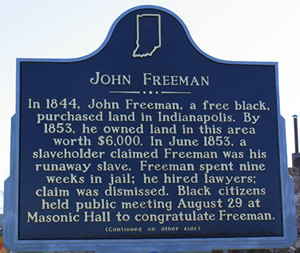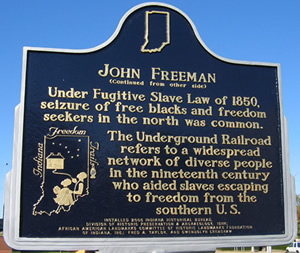

Location: On the west side of Pennsylvania Street between 10th and 11th streets, in greenspace next to the Landmark Center, located at 1099 N. Meridian Street, Indianapolis. (Marion County, Indiana)
Installed: 2005 Indiana Historical Bureau, Division of Historic Preservation & Archaeology, IDNR; African American Landmarks Committee of Historic Landmarks Foundation of Indiana, Inc.; Fred A. Taylor, and Gwen Crenshaw
ID# : 49.2006.2
Text
Side one:
In 1844, John Freeman, a free black, purchased land in Indianapolis. By 1853, he owned land in this area worth $6, 000. In June 1853, a slaveholder claimed Freeman was his runaway slave. Freeman spent nine weeks in jail; he hired lawyers; claim was dismissed. Black citizens held public meeting August 29 at Masonic Hall to congratulate Freeman.
Side two:
Under Fugitive Slave Law of 1850, seizure of free blacks and freedom seekers in the north was common. The Underground Railroad refers to a widespread network of diverse people in the nineteenth century who aided slaves escaping to freedom from the southern U.S.
Keywords
Underground Railroad, African American, Government Institutions
Annotated Text
In 1844, John Freeman, a free black, purchased land in Indianapolis.(1) By 1853, he owned land in this area worth $6, 000.(2) In June 1853, a slaveholder claimed Freeman was his runaway slave.(3) Freeman spent nine weeks in jail; he hired lawyers; claim was dismissed.(4) Black citizens held public meeting August 29 at Masonic Hall to congratulate Freeman.(5)
Under Fugitive Slave Law of 1850, seizure of free blacks and freedom seekers in north was common.(6) The Underground Railroad refers to a widespread network of diverse people in the nineteenth century who aided slaves escaping to freedom from the southern U.S.
Notes:
1.Deed, John N. Dearinger to John Freeman, September 23, 1844, Marion County Indiana Deed Records, Book O, p. 533, Indiana State Library, microfilm; Indianapolis Locomotive, September 3, 1853. The land purchased by Freeman in 1844 was the West 1/2, Lot 12, Square 14 in the Town of Indianapolis. Today that location is the SE corner of Capitol and Michigan streets.
2.Henry Ward Beecher, "The Minister Hunting His Slave, " Boston Liberator, July 29, 1844. From 1848 through 1851, Freeman purchased 4 parcels of land in Lot 4, in St. Clair's Addition, located in the present-day St. Joseph's Historic District. The boundaries of which are I-65, Ft. Wayne and Central Avenues, St Clair, and Meridian streets, including the proposed marker location at Meridian and 10th streets.
3.Indianapolis Locomotive, June 25, 1853.
4.Indianapolis Locomotive, September 3, 1853; Charles H. Money, "The Fugitive Slave Law in Indiana, " Indiana Magazine of History, 17 (1921):186-87. The claim was heard by a U.S. Commissioner, as established by the Fugitive Slave Act of 1850.
5.Indiana Free Democrat, September 1, 1853. One article reports on whites gathered in the afternoon to discuss the Fugitive Slave Act, George Julian was one of the speakers. Two articles describe the meeting of blacks in the evening to congratulate Freeman on his victory and to pass resolutions pertaining to the evil perpetuated by the Fugitive Slave Act. Whites were in attendance at the evening event; blacks do not seem to have been involved at the afternoon meeting.
6. "Eric Foner on the Fugitive Slave Act," Africans in America, accessed October 27, 2004.
